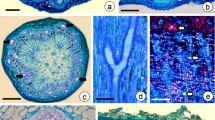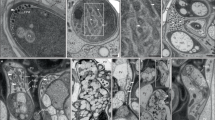Abstract
We investigated the three-dimensional ultrastructure of feeding tubes and the surrounding region in giant cells induced in rose balsam (Impatiens balsamina L.) roots by the root-knot nematode Meloidogyne incognita, using osmium maceration coupled with field emission scanning electron microscopy (FE-SEM). In the roots of 35-day-old galled rose balsam plants, adult nematodes induced the formation of giant cells containing feeding tubes and numerous organelles, including tubular endoplasmic reticulum (ER), cisternal ER, and mitochondria. The feeding tubes were surrounded by fine tubular structures (20–50 nm in diameter), which were in turn surrounded by tubular ER (approximately 120 nm in diameter). The termini of the fine tubular structures appeared to be connected to the surface of the feeding tubes, suggesting that the fine tubular structures were continuous with narrow channels in the feeding tubes. The tubular ER arose from cisternal ER. Large bundles of tubular ER were present near the feeding tube, in the centers of the giant cells, and in the peripheral regions of the giant cells, such as cell wall ingrowths, while smaller bundles of tubular ER formed networks in the giant cells. These observations suggest that tubular ER functions as vascular bundles in giant cells, facilitating the transport of nutrients. We identified capsule-shaped structures (30 μm in diameter) in the giant cells that consisted of smooth, repeatedly branched ER tubules wrapped in several layers of cisternal ER. We propose that lipids and steroids are synthesized at the smooth branched ER and stored in these capsules until needed by the nematode.









Similar content being viewed by others
Abbreviations
- CWI:
-
Cell wall ingrowth
- FT:
-
Feeding tube
- GC:
-
Giant cell
- HN:
-
Head of nematode
- St:
-
Stylet
- tER:
-
Tubular ER
- Xy:
-
Xylem
References
Barcala M, Garcia A, Cabrera J, Casson S, Lindsey K, Favery B, Garcia-Casado G, Solano R, Fenoll C, Escobar C (2010) Early transcriptomic events in microdissected Arabidopsis nematode-induced giant cells. Plant J 61:698–712
Bartlem DG, Jones MGK, Hammes UZ (2013) Vascularization and nutrient delivery at root-knot nematode feeding sites in host roots. J Exp Bot 65:1789–1798
Bird AF (1961) The ultrastructure and histochemistry of a nematode-induced giant-cell. J Biophys Biochem Cytol 11:701–715
Bird AF (1968) Changes associated with parasitism in nematodes. IV. Cytochemical studies on the ampulla of the dorsal esophageal gland of Meloidogyne javanica and on exudations from the buccal stylet. J Parasitol 54:879–890
Bird AF (1972) Quantitative studies on the growth of syncytia induced in plants by root knot nematodes. Int J Parasitol 2:157–170
Bird AF, Saurer W (1967) Changes associated with parasitism in nematodes. II. Histochemical and microspectrophotometric analyses of preparasitic and parasitic larvae of Meloidogyne javanica. J Parasitol 53:1262–1269
Chitwood DJ, Lusby WR (1991) Metabolism of plant sterols by nematodes. LIPID 26:619–627
Davis EL, Hussey RS, Mitchum MG, Baum TJ (2008) Parasitism proteins in nematode-plant interactions. Curr Opin Plant Biol 11:360–366
Deslandes L, Rivas S (2011) The plant cell nucleus—a true arena for the fight between plants and pathogens. Plant Signal Behav 6:42–48
Feng Z, Chen X, Bao Y, Dong J, Zhang Z, Tao X (2013) Nucleocapsid of tomato spotted wilt tospovirus forms mobile particles that traffic on an actin/endoplasmic reticulum network driven by myosin XI-K. New Phytol 200:1212–1224
Gunning BES, Pata JS, Briarty LG (1968) Specialized “transfer cells” in minor veins of leaves and their possible significance in phloem translocation. J Cell Biol 37:C7–12
Hammes UZ, Schachtman DP, Berg RH, Nielsen E, Koch W, McIntyre LM, Taylor CG (2005) Nematode-induced changes of transporter gene expression in Arabidopsis roots. Mol Plant-Microbe Interact 18:1247–1257
Harris N (1979) Endoplasmic reticulum in developing seeds of Vicia fava. Planta 145:63–69
Harris N (1986) Organization of the endomembrane system. Ann Rev Plant Physiol 37:73–92
Haseloff J, Siemering KR, Prasher DC, Hodge S (1997) Removal of a cryptic intron and subcellular localization of green fluorescent protein are required to mark transgenic Arabidopsis plants brightly. Proc Natl Acad Sci 94:2122–2127
Hawes C, Saint-Jore C, Martin B, Zheng HQ (2001) ER confirmed as the location of mystery organelles in Arabidopsis plants expressing GFP. Trends Plant Sci 6:245–246
Hepler PK, Palevitz BA, Lancelle SA, Mccauley MM, Lichtscheidl I (1990) Cortical endoplasmic reticulum in plants. J Cell Sci 96:355–373
Hok S, Attard A, Keller H (2010) Getting the most from the host: how pathogens force plants to cooperate in disease. Mol Plant-Microbe Interact 23:1253–1259
Holtmann B, Kleine M, Grundler FMW (2000) Ultastructure and anatomy of nematode-induced syncytia in roots of susceptible and resistant sugar beet. Protoplasma 211:39–50
Hoth S, Stadler R, Sauer N, Hammes UZ (2008) Differential vascularization of nematode-induced feeding sites. Proc Natl Acad Sci U S A 105:12617–12622
Hussey RS, Mims CW (1991) Ultrastructure of feeding tubes formed in giant-cells induced in plants by the root-knot nematode Meloidogyne incognita. Protoplasma 162:99–10
Jammes F, Lecomte P, de Almeida-Engler J, Bitton F, Martin-Magniette ML, Renou JP, Abad P, Favery B (2005) Genome-wide expression profiling of the host response to root-knot nematode infection in Arabidopsis. Plant J 44:447–458
Jaouannet M, Perfus-Barbeoch L, Deleury E, Magliano M, Engler G, Vieira P, Danchin EGJ, Rocha MD, Coquillard P, Abad P, Rosso MN (2012) A root-knot nematode-secreted protein is injected into giant cells and targeted to the nuclei. New Phytol 194:924–931
Jones MGK, Dropkin VH (1976) Scanning electron microscopy of nematode-induced giant transfer cells. Cytobios 15:149–161
Jones MGK, Northcote DH (1972a) Multinucleate transfer cells induced in coleus roots by the root-knot nematode, Meloidogyne arenaria. Protoplasma 75:381–395
Jones MGK, Northcote DH (1972b) Nematode-induced syncytium: a multinucleate transfer cell. J Cell Sci 10:789–809
Jones MGK, Payne HL (1978) Early stages of nematode-induced giant-cell formation in roots of Impatiens balsamina. J Nematol 10:70–84
Koga H, Tsukiboshi T, Uematsu T (1992) Application of an osmium-maceration technique to observe plant-microbe interfaces of Italian ryegrass and crown rust fungi by scanning electron microscopy. Can J Bot 70:438–442
Koga H, Tsukiboshi T, Uematsu T (1993) The structure of the cell organelles of plant leaves revealed by high resolution scanning electron microscopy. Bull Natl Grassl Res Inst 47:37–43
Krstic’ RV (1979) Ultrastructure of the mammalian cell. Springer-Verlag, Berlin Heidelberg, pp 98–99
Krusberg LR, Hussey RS, Fletcher CL (1973) Lipid and fatty acid composition of females and eggs of Meloidogyne incognita and M. arenaria. Comp Biochem Physiol Part B: Biochem Mol Biol 45:335–341
Marella HH, Nielsen E, Schachtman DP, Taylor CG (2013) The amino acid permeases AAP3 and AAP6 are involved in root-knot nematode parasitism of Arabidopsis. Mol Plant-Microbe Interact 26:44–54
Matsushima R, Hayashi Y, Kondo M, Shimada T, Nishimura M, Hara-Nishimura I (2002) An endoplasmic reticulum-derived structure that is induced under stress conditions in Arabidopsis. Plant Physiol 130: 1807–1814
Miyashita N, Yabu T, Kurihara T, Koga H (2014) The feeding behavior of adult root-knot nematodes (Meloidogyne incognita) in rose balsam and tomato. J Nematol 46:296–301
Offler CE, McCurdy DW, Patrick JW, Talbot MJ (2002) Transfer cells: cells specialized for a special purpose. Annu Rev Plant Biol 54:431–454
Okumoto S, Schmidt R, Tegeder M, Fischer WN, Rentsch D, Frommer WB, Koch W (2002) High affinity amino acid transporters specifically expressed in xylem parenchyma and developing seeds of Arabidopsis. J Biol Chem 277:45338–45346
Paulson RE, Webster JM (1970) Giant-cell formation in tomato roots caused by Meloidgyne incognita and Meloidogyne hapla (Nematoda) infection. A light and electron microscope study. Can J Bot 48:271–276
Peng B, Kong H, Li Y, Wang L, Zhong M, Sun L, Gao G, Zhang Q, Luo L, Wang G, Xie W, Chen J, Yao W, Peng Y, Lei L, Lian X, Xiao J, Xu C, Li X, He Y (2014) OsAAP6 functions as an important regulator of grain protein content and nutritional quality in rice. Nat Commun. doi:10.1038/ncomms5847
Razak AR, Evans AAF (1976) An intracellular tube associated with feeding by Rotylenchulus reniformis on cowpea root. Nematologica 22:182–189
Rebois RV (1980) Ultrastructure of a feeding peg and tube associated with Rotylenchulus reniformis in cotton. Nematologica 26:396–405
Ridge RW, Uozumi Y, Plazinski J, Hurley UA, Williamson RE (1999) Developmental transitions and dynamics of the cortical ER of Arabidopsis cells seen with green fluorescent protein. Plant Cell Physiol 40:1253–1261
Sasser JN, Freckman DW (1987) A world perspective on nematology; the role of society. In: Veech JA, Dickson DW (eds) Vistas on Nematology. Society of Nematologists, Hyattsville, Maryland, pp 7–14
Sobczak M, Golinowski W, Grundler FMW (1999) Ultrastructure of feeding plugs and feeding tubes formed by Heterodera schachtii. Nematology 1:363–374
Staeheline LA (1997) The plant ER: a dynamic organelle composed of a large number of discrete functional domains. Plant J 11:1151–1165
Stephenson JLM, Hawes CR (1986) Stereology and stereometry of endoplasmic reticulum during differentiation in the maize root cap. Protoplasma 131:32–46
Tanaka K, Mitsushima A (1984) A preparation method for observing intracellular structures by scanning electron microscopy. J Microsc 133:213–222
Tanaka K, Naguro T (1981) High resolution scanning electron microscopy of cell organelles by a new preparation method. Biomed Res 2:63–70
Van Gundy SD, Bird AF, Wallace HR (1967) Aging and starvation in larvae of Meloidogyne javanica and Tylenchulus semipenetrans. Phytopathology 57:559–571
Wergin WP, Orion D (1981) Scanning electron microscope study of the root-knot nematode (Meloidogyne incognita) on tomato root. J Nematol 13:358–367
Wu CH, Lee SC, Wang CW (2011) Viral protein targeting to the cortical endoplasmic reticulum is required for cell–cell spreading in plants. J Cell Biol 193:521–535
Wyss U, Zunke U (1986) Observations on the behavior of second stage juveniles of Heterodera schachtii inside host roots. Revue Nematol 9:153–165
Wyss U, Stender C, Lehmann H (1984) Ultrastructure of feeding sites of the cyst nematode Heterodera schachtii Schmidt in roots of susceptible and resistant Raphanussativus L. Var. oleiformis Pers. Cultivars. Physiol Plant Pathol 25:21–37
Wyss U, Grundler FMW, Munch A (1992) The parasitic behaviour of second-stage juveniles of Meloidogyne incognita in roots of Arabidopsis thaliana. Nematologica 38:98–111
Author information
Authors and Affiliations
Corresponding author
Additional information
Handling Editor: Liwen Jiang
Rights and permissions
About this article
Cite this article
Miyashita, N., Koga, H. Three-dimensional ultrastructure of feeding tubes and interconnected endoplasmic reticulum in root-knot nematode-induced giant cells in rose balsam. Protoplasma 254, 1941–1951 (2017). https://doi.org/10.1007/s00709-016-1072-x
Received:
Accepted:
Published:
Issue Date:
DOI: https://doi.org/10.1007/s00709-016-1072-x




